Agronomy Update: Let’s Talk About Harvest
BY DAIRYLAND SEED AGRONOMY TEAM
CROWN AND STALK ROTS & THE IMPORTANCE OF SCHEDULING HARVEST ORDER
With the wet weather we experienced during the first week of October and the potential for more rain, wind, and in some areas snow, prioritizing which corn fields need to be harvested first, and which ones can wait, will be of great importance. In walking corn fields, we are seeing crown and stalk rots already having an effect on plant health, as well as standability. It has been my experience that once we get into October and November, the more wind events we receive, making standability less and less likely, or so it seems. The photo below shows a corn plant with Fusarium that has both crown and stalk rot.
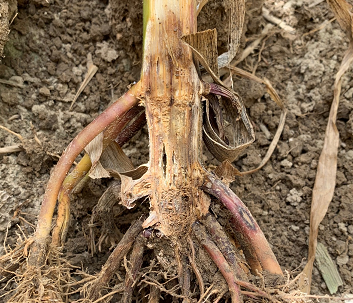
In most situations the reasons we are seeing more crown and stalk rots this year compared to other years, is being forced to plant in “less than ideal conditions” which forced many corn plants to be subjected to cool or cold water early in its growth cycle. Sidewall compaction, fertility deficiencies as well as cool wet soils increase the incidence of crown and stalk diseases.
The disease that I believe most prevalent this will be Fusarium. Other diseases that I anticipate seeing due to our cooler wetter growing season will be:
- Anthracnose which is mainly thought of as top dieback disease but the more advanced stages of the disease show black lesions on the stalk
- Physoderma Brown Spot which in most instances is a leaf disease but can cause stalks rots that is associated with a brown or black ring around one or several of the lower nodes on the stalk
- Diplodia Stalk Rot can be found in both the stalk and the ear or kernels with stalks and kernels a rough texture it tends to cause affected tissue to have black fungal formations on it
- Gibberella Stalk Rot which is very similar in appearance to Fusarium and is tough to discern which one it is due to both cause pink/red or salmon colors inside the stalk
The procedure that I follow to check fields is to review which fields were planted in “less than ideal conditions” as well shorter day hybrids and scout them first. I will then walk across a portion of the field and perform Pinch, Push, Shove and Slash tests along the way looking at both green healthy plants and also plants that are yellow/tan and or stunted:
- Pinch the stalks 4-8” off the soil level if it collapses you have a crown or stalk rot, or both
- Push the stalks so the top of the plant touches the row across from it, if it buckles under that pressure odds are you have a stalk rot
- Shove a few stalks down the row and see how much pressure it takes to break them, the less pressure it takes to break them increases the probability of standability issues
- Slash or cut the stalk 10-12” above the soil line with a sharp knife down to or through the roots, (remember to be safe and cut away from yourself) I generally will dig the plant first. The crown and stalk should be a white or creamy color, (the photo below shows a healthy stalk and root on the left, whereas, the stalk and root on the right is not healthy) if it is not that plant has a crown or stalk rot
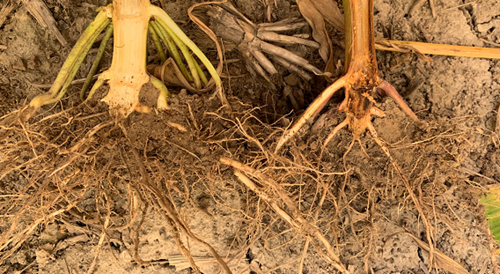
The more plants that fail these tests increases the odds that you will need to harvest that field early or move it up in the harvest schedule. Remember that these affected plants will be more susceptible to wind damage the longer the harvest window gets.
Having and following a harvest order decreases the likelihood of harvesting down corn, and increases the likelihood of capturing more yield but also having a safer and less stressful harvest season.
LATE SILAGE HARVEST
Weather delays have continued with silage still standing in the field for most farmers. Once the weather clears, what should we do? GO CHOP! Well, that seems to be an obvious answer, but check out these points as you dive in.
- Continue whole-plant moisture samples to ensure best quality. Also be sure that a good nutritionist is your best friend in the coming months!
- If a crop is killed early by frost, continue to let it dry to your target moisture. Frost killed corn will appear dryer than it is, so do your whole-plant moisture tests. Leaves will begin to drop, so be aware of some dry matter loss as drying continues.
- If your silage is too dry (DM% >40), strive for a smaller particle size to improve packability in storage. Be sure to use a kernel processor if available.
- Consider the harvest cutting height tradeoff. We have two years of data from our Product and Agronomy Research (PAR) Plot in Mt. Hope, WI where we compared 6” and 18” harvest heights. We suggest a higher cutting height unless the farm needs tonnage, or if they need a couple points of moisture added to the crop. In most cases the gain in tonnage from a lower cutting height is not worth the loss in quality. We have found that that the 6” cutting height will do the following:
- Increase yield by 0.6 T/Ac dry matter on average. 0.3T in 2017 and 0.9T in 2018.
- Increase moisture content by 2.6 points. The lower stalk is the wettest part of the plant.
- Decrease NDFd % by 4.3 points.
- Decrease starch % by 2.8 points.
- Milk/Ac and milk/T differences have been minimal for us, but more robust university testing has found increases in milk/ac by 1.7% and decreases in lb milk/ton by 5.2%
- Our research agrees quite well with university studies. Penn State University offers a great summary here: https://extension.psu.edu/considerations-in-managing-cutting-height-of-corn-silage
CHECK FIELDS FOR EAR ROTS PRIOR TO HARVEST
When you have a chance, check your corn fields prior to harvest for ear rots. The most common ear rots are Diplodia, Gibberella, Fusarium and Aspergillis. All may produce Mycotoxins except for Diplodia. It is important that the ear rot be identified and possibly be checked for mycotoxins prior to harvest so that risk reduction measures can be taken. If ear rot is discovered:
- Identify the ear rot.
- If the ear rot has been identified as a potential mycotoxin producer – have it tested.
- Harvest ear rot infested fields as soon as possible and dry to less than 15% moisture.
- Cool grain to less than 55 degrees.
- Adjust combine to minimize grain damage.
Common Ear Rot ID
Aspergillis:
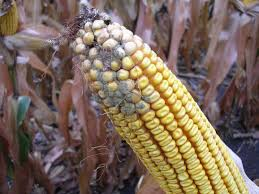
- Mycotoxins may occur
- Drought, high temperatures and high humidity favors development
- Color may vary from green to yellow to a brownish powdery mold that forms between the kernels.
- Commonly occurs where insects or birds have damaged the kernels.
Gibberella:
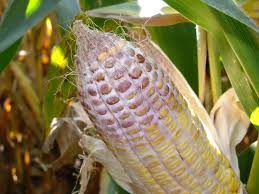
- Mycotoxins can form
- Same pathogen that causes head scab in wheat and small grains
- Spores disperse from infected residue of corn, wheat and small grains.
- Infection begins developing on young silks
- Favors cool wet weather during and after pollination
- A pinkish fuzzy mold
Fusarium:
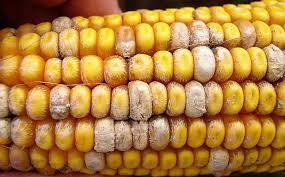
- Produces mycotoxins
- Survives on infected residue
- Warm dry weather favors development
- Disease enters plant through wounds caused be insects, hail and wind damage
- Can be white to pink in color, a starburst design may be seen the kernel.
Diplodia:
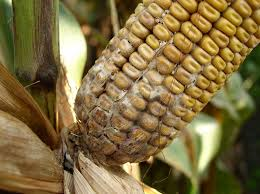
- Does not produce mycotoxins
- May cause ear rot, stalk rot and seedling blight
- Wet weather, moderate temperatures during silking through early dough stage favors development.
- Survives on infected corn residue from the previous years
- A tight husk, wet weather and upright ears predispose the ear to diplodia ear rot
- First appears at the base of the ear.
Please contact your Dairyland Seed agronomy team member if you need assistance in identifying any ear rot concerns.
 |
 |
 |
 |
 |
| Brian Weller Western Region 507.456.3034 |
Dan Ritter Central Region 219.863.0583 |
Branden Furseth Northern Region 608.513.4265 |
Rod King Eastern Region 574.596.6721 |
Terry Jones Eastern Region 419.630.3115 |
